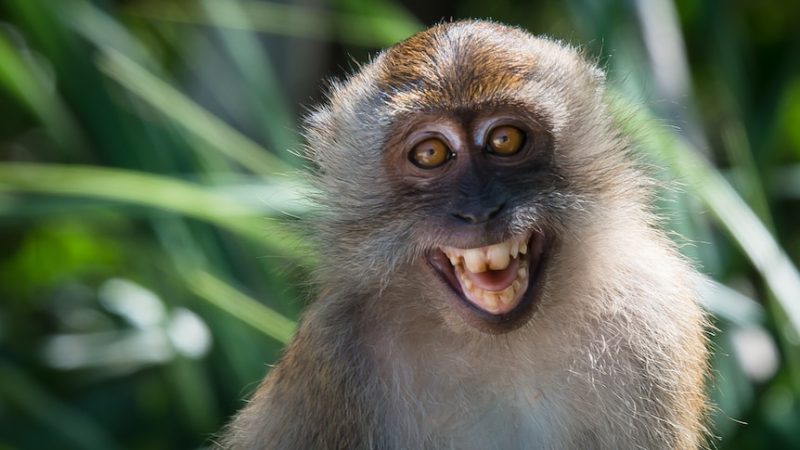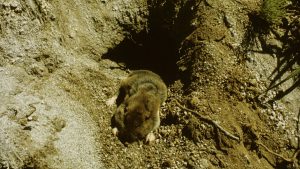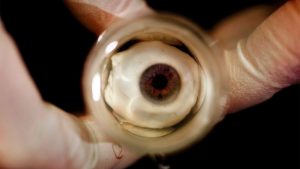Scientists create monkey chimera using stem cells method for the first time

A monkey born in China with green fluorescence in its brain and eyes was the first live-born “chimera” of its kind.
Key points:
- Scientists in China say they created a monkey chimera using stem cells injected into an embryo
- Chimeras are organisms that contain cells from two or more individuals
- Researchers hope the breakthrough will aid medical research into things like motor neuron disease
The green glow in many of the monkey’s tissues is proof that it was created partially from a normal embryo and partially from stem cells: a method only previously used in mice and rats.
The scientists behind the creation of this monkey chimera, which has been detailed in the journal Cell, hope to refine the process in primates to better study treatments for neurodegenerative diseases.
But what even is a chimera?
The term comes from the fire-breathing creature of Greek mythology which looks like a lion, with a goat head sticking out of its back and a snake’s head and body for a tail.
‘Chimera’ is now used for any fictional hybrid creature made up of parts of various animals.
But it also applies to a real life biological phenomenon: chimerism in animals is where a single organism contains the cells of one or more individuals.
The first lab-born chimeras were mice in the early 1960s when embryologists Andrzej Tarkowski and Beatrice Mintz combined embryos together.
The same technique was then used in pigs, sheep, rabbits, cattle, rats and monkeys.
In the 1980s, a different technique was developed where stem cells were taken from one embryo and placed into a different one.
Stem cells are the raw building blocks of multi-cell organisms — they have the ability to divide and turn into other cell types.
Injecting stem cells into an embryo has been done successfully in mice and rats, but not primates.
How was this monkey chimera created?
The scientists from the Chinese Academy of Sciences (CAS) and several support institutions chose the crab-eating macaque (Macaca fascicularis) for their research.
They removed stem cells from seven-day-old macaque blastocysts — the initial stage of an embryo.
These embryonic stem cells were then grown in the lab and tested to make sure they were pluripotent, which means they can turn into other cell types to form tissues and organs.
Before injecting them into host embryos, the stem cells were marked with a green fluorescent protein so researchers could tell later what tissues had grown from the donor stem cells and which were from the host embryo.
Forty surrogate monkeys were then injected with treated embryos.
Twelve monkeys became pregnant and six made it to full term about 160 days later.
In the end, one of the living offspring and one miscarried fetus, both male, displayed chimerism.
Analysis of the live chimeric monkey showed there was an average of 67 per cent contribution of genetic material from donor embryonic stem cells in the 26 tissues studied.
The highest level of embryonic stem cell contribution was 92 per cent in the monkey’s brain.
But the chimeric monkey baby had serious health issues after it was born and was euthanised after 10 days because of respiratory problems.
Why create a monkey chimera with stem cells?
CAS Institute of Neuroscience scientific director Mu-ming Poo, who was involved in the first instance of cloning crab-eating macaques in 2018, said the research showed particular promise for studying neurological disease.
“Mouse models in many ways don’t assimilate to humans very well, especially for brain disease,” Dr Poo said.
“I think editing macaque stem cells and then producing a macaque chimera with human disease genes for ALS [amyotrophic lateral sclerosis] will be the highest priority.”
Adelaide Centre for Epigenetics director Professor Jose Polo, who was not involved in the paper, said given similar experiments were not permissible in people, such studies were invaluable for understanding human developmental processes.
“Transgenic mice have been transformational for our understanding of multiple diseases, however in some cases mice models are not able to accurately reflect human disease,” he said.
“In the future, this technology could be used for generating transgenic non-human primates which could provide a critical tool for better understanding certain human diseases and potentially play a pivotal role in discovering cures.”
Why is this chimera special?
One of the study authors Miguel Esteban, from CAS and Chinese genomics company BGI, said the difference with the results to previous monkey chimeras was the high level of donor cells present.
“We have a very high level of contribution with the donor cells forming a big part of the tissues — complex structures all over the monkey body,” he said.
“Efficiency is something that we need to improve so it becomes reproducible.”
Rats and mice pregnancies go for about 20 days and result in litters with multiple pups which makes for plenty of test subjects.
Monkeys on the other hand have gestation periods greater than 150 days for a single offspring, making it a long and expensive process to get a chimera.
Another issue for the scientists is getting the chimera to live longer.
What are the ethical issues around this type of research?
While the researchers ultimately want to make breakthroughs that will benefit human health, there are animal rights groups in Australia which want to see experimentation on different species stopped.
Animal research in Australia and many overseas countries must go through stringent ethics assessments.
Leading stem cell researcher Professor Megan Munsie, of the University of Melbourne and Murdoch Children’s Research Institute, said the first question of animal research should be why is it required.
“All animal research warrants careful consideration, but this is particularly important for all non-human primate research,” she said.
“And where there is a strong scientific justification, ask how researchers will ensure that the animals receive the best possible care.”
Dr Munsie said although the research in the Cell paper may help us understand human development and species conservation better, a lot of the chimeric embryos did not result in a viable pregnancy.
“Of the 74 embryos transferred to 40 surrogates, there was only one chimeric monkey born – which subsequently died of respiratory failure,” she said.
“As noted in the paper, future efforts in this area need to first review and improve embryo viability to avoid the high abortion rate and associated distress and waste.”
The crab-eating macaque was upgraded to endangered status on the international threatened species list last year.
Dr Munsie said research should be limited to animals that were not endangered.
Get all the latest science stories from across the ABC.







